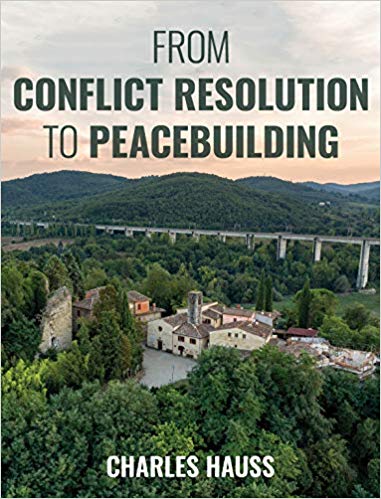
To Teach Peace You Have to Practice Peace
My new book, From Conflict Resolution to Peacebuilding, will be published in a few weeks. Because it is an introductory textbook for peace and conflict studies courses, my editors asked me to write an instructor’s guide in part because I’ve done them before. In this case, I’m finding it hard to do and it took me a while to figure out why.
In the end, it’s all about practicing what you preach.
Or, in this case to teach peace, you have to practice peace.
With an emphasis of practice.
A Work in Progress
After hours of discussions with myself (aka daydreaming and procrastinating) and some time with my therapist, I finally realized that writing an instructor’s guide or manual for this kind of course was going to be very different from writing one in comparative politics, which is my other academic field.
Put simply, I realized (with the help of my musings and weekly therapeutic hour) that I can’t write about teaching peace and conflict resolution without writing about living the values of a peacebuilder or conflict resolver. And I can’t do that without coming to grips with the fact that I still have a lot to learn about them. Which means that I’m still learning about what I wrote about.
That’s not an intellectual problem.
It’s a practical one. We are all works in progress when it comes to peacebuilding and conflict resolution.
A Take on Teaching: Part 1
And that got me to this blog post, which is the first of several I will write over the next few weeks which will then get morphed into the instructor’s guide.
That led me to realize that while I may know a lot about peacebuilding and conflict resolution, I have a lot to learn about most (maybe all?) of the concepts the book is built around.
So, what I thought would be the first blog post—“owning” your own course—got put off for a week.
I have to start with “living” your course. Or, in my case, your own instructor’s guide.
If you are going to teach peace well, you have to live peace well. And, that is a never ending struggle.
It’s also gives me a regular lesson in humility. I was asked to write this book both because I’ve been doing this work for a long time and am pretty good at connecting the intellectual dots among the disparate ideas and events that make up peace and conflict studies today.
My Top Five Challenges
Were I still teaching, these would be the issues I would work on before I started my course. They are the issues I still have to work on in my life as a practitioner and a writer. Here are a few that I have found that I still have to work on after half a century of teaching and building peace. Some are part of the peacebuilding canon. Some come out of the unusual ways I approach the subject. But they are all things I thik about every day.

Teaching at Rondine
And, they give me constant doses of humility. So, let me take my top five.
- Listening. I learned how much I still have to learn on this front when I was asked to spend a morning with the second year group of students at Rondine who come from conflict zones around the world. They wanted to learn about what I do at AfP, but I also had to listen to them. About their experiences in Mali or Georgia or their hopes for what they could accomplish when they go back home a year from now. I had to remember that what I said to them was important. So was what they had to say to me.
- Curiosity. You need to be curious. Not just about the subject matter. But about your students, too. I’ve never taught a course in which a few students’ back stories did not enhance my professional life. I even saw that in a day I spent at a summer camp GMU runs for high school students. A bright engaged young woman talked to me about her coding classes and how they had helped her mature. A few days later, she and I had come up with the idea of creating badges and certificates that students could earn.
- Empathy. This is a big buzzword these days, and we often stretch its meaning way too far. In my case, I mean “simply” that a good peacebuilder or a good teacher has to be able to figure out why his/her interlocutors think the way they do. I don’t have to agree with everyone I work with. I do have to understand and respect them. I still work with two students I taught in the 1980s who went off to have distinguished military careers. I’ve spent the limited time we’ve spent together trying to understand—and not judge—the decision making that led them to a career in uniform. It’s not just your students who go into the military. It’s every one you work with.
-
Build on small victories. A few weeks ago, I belatedly discovered Debra Meyerson’s work on tempered radicals or people who choose to make radical changes in a system by working from within. Then, I discovered her new career as a stroke survivor. In both, she talks about helping others and herself win small victories, a concept she first learned from her mentor, Karl Weick. Now, she applies it to herself. Sure, she’s frustrated by the fact that she can’t recover everything she lost from her stroke nearly a decade ago. But, she relishes in and tries to build off of the small gains she makes. That holds for teaching—or doing anything else about—peace. I jokingly say that I majored in ending the war in Vietnam by Thursday as an undergraduate. Now, even though I know that change comes one step at a time, I forget it a lot. Especially in dealing with students. If I learn slowly and that’s OK, it’s OK if they do, too. Don’t expect epiphanies left and right in each class. Once in a while will do. Just be sure you build on them.
- Help them make choices. I’m currently reading Bruce Deel’s Trust First. It’s not the kind of book I’d normally read. Deel is an evangelical pastor in Atlanta where he has built an amazing social service network for the most underprivileged of the city’s poor as part of his ministry, City of Refuge. Among other things, he learns and relearns and relearns again a message all teachers (and preachers) have to learn and remember. I can’t convince you of anything. All I can do is help give you the tools that you can use in making your own choices. When I teach about peacebuilding and conflict resolution, I’d love it if my students decided to devote their lives to my chosen profession, too. I’ve watched plenty of my colleagues “preach” to their students. Sometimes, the students go along—at least until the final grades are in. I know I’ve done it, too. Mea culpa.
I suspect you have your own top five list of peacebuilding concepts and skills that you have to work on, and you will have to make you own list of them before you design your own course—with or without my book.
Next week: Owning Your Course
Next time, I’ll get back on what I thought was my schedule and talk about the importance of design thinking in peace and conflict education.
The views and opinions expressed in this article are those of the author and do not necessarily reflect the official policy or position of the Alliance for Peacebuilding or its members.
Click edit button to change this text.
Also published on Medium.








